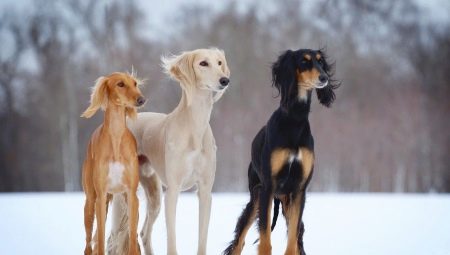Saluki is one of the oldest breeds. Many believe that they were the first dogs to settle next to a person. Saluki gained immense popularity due to their hunting qualities and friendliness.
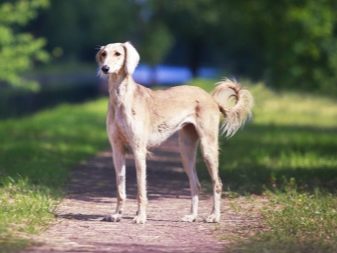

Origin history
Saluki is considered one of the first first breeds tamed by man. Its historical homeland is the Middle East and North Africa (primarily Ancient Egypt). This opinion was first expressed by the scientist L.P. Sabaneev in the 19th century. In his work, he put forward the assumption that the ancestor of all greyhounds were tezems - greyhounds of the pharaohs. They looked like a saluk physique, but had erect ears and a tail wrapped.
The researcher believed that four similar breeds came from them: saluki (Egypt, Saudi Arabia, Iraq and Iran), sluts (Tunisia and Morocco), Azawaki (southern Sahara) and bell-mura (African greyhounds of the flat and mountain type).
The appearance of these rocks on such a large territory was connected by the Sabaneys with the colonization of the area by the Phoenicians and the resettlement of Arabian tribes (c. 3000 BC). This opinion prevailed until the middle of the 20th century.
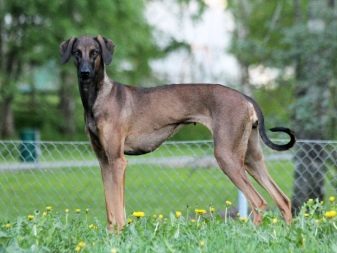
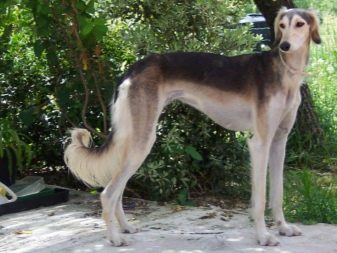
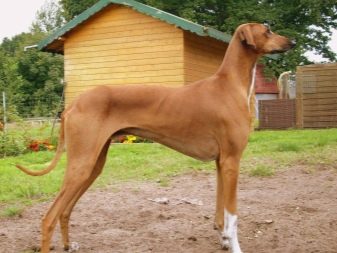
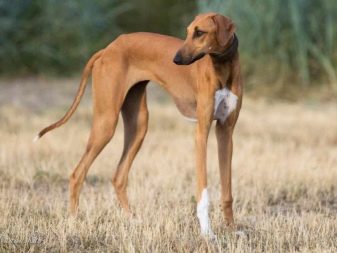
In 1959, the researcher S.N. Bogolyubsky published a work in which he suggested the origin of saluki and tezems from a common ancestor. He debunked the myth that the Saluki were descended from the tezems, and singled out two forms of greyhounds - North African and Eurasian. They acquired differences due to living in different conditions and gave rise to several breeds of greyhounds and two different centers of their distribution, and later met on the same territory.
At the moment, scientists agree that the Bogolyubsky theory more accurately describes the development of the Saluki breed. The appearance of these dogs is attributed to the XI - X century BC. e.and consider them a separate breed, which until 4000 BC. e. was influenced by tezems. After the II millennium BC. e. tezems ceased to play a decisive role in the distribution of greyhounds, and saluki came to the fore.
However, the separation of greyhounds from the Arabian Peninsula and dogs descended from tezems is very arbitrary.
The images found in Egypt contain greyhound greyhounds (typical for saluki), and on the islands of the Mediterranean Sea there are greyhounds with erect ears (for example, Ibiza dogs) that could have been brought there by Arabs during the campaigns in IX-XI centuries.

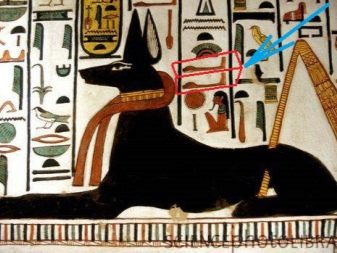
Scientists have no consensus about when exactly these dogs began to live with a person. However, we can trace the origin and development of these animals by the mummies found in Egyptian tombs, cave paintings and poetry.
The first mention of these dogs was found in Egypt and belong to the period when the pharaohs did not exist yet - 9000 - 10000 years BC. e. The oldest mummy of dogs of the Saluki breed belongs to this period. The verses of the Arab poet Abu Nuwas dating from the 9th-8th centuries are known. BC e., which he devotes to his saluki. Abu Nuwas calls her “salucation”:
“How can I glorify the Saluki who belongs to me?
His hunting luck forever will not run away from him!
All the goodies that I have, my hunting trophies -
His merit and booty, my guest is fed up with his labors. ”
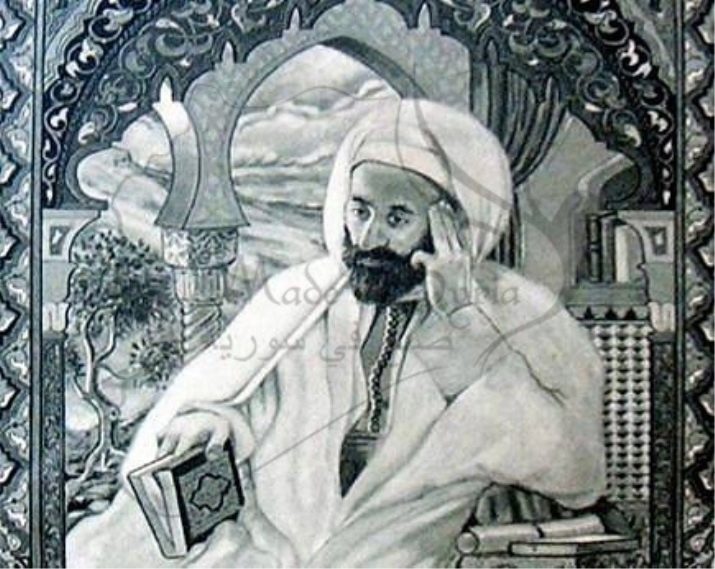
In 7-6 t. BC. e. the breed finally took shape and spread throughout the Middle East. This period includes the head of a saluki carved from ivory, found on the territory of the Arabian Peninsula. This breed is also mentioned in the verses of Persian poets, which date back to 3000 BC. e. The next oldest find was made in Egypt: in one of the pyramids a barillef was discovered, which depicted hunting scenes with red and red-colored pinto dogs.
Interestingly, this breed was so highly valued in Egypt that they made special collars encrusted with precious stones, while Arabs and Bedouins settled them in their tents.
Muslims considered them “pure animals” and never called the greyhounds “al-kalb” (dog), as this was considered the greatest insult. Instead, the word al-hur (noble) was used. They have never been bought or sold. Salyuk could be presented to close relatives and friends. As a thank you for such a gift, a person could ask for anything.
The position of the saluki was so exceptional that after a Muslim petting a dog, he could go to the mosque and perform only those prayers that he wanted. At the same time, he did not lose “purity”, as it happened when in contact with any other animal (except the horse).
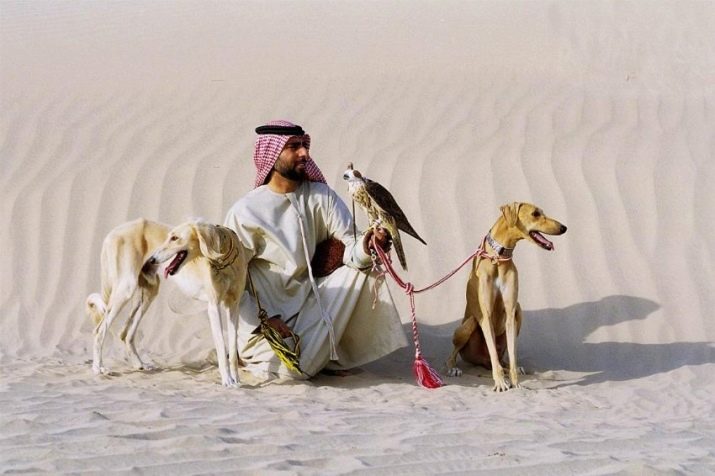
Salyuk was never laid on the ground and was not left unattended on the street. In the cities for their recreation, special floorings were built under the roofs of houses. In the tents of the Bedouins, they lived on the territory of women behind the curtain on a special bedding. At night and on cold days, they were covered with a warm blanket, and on hot days, women sewed light cloaks that protected dogs from burns.
During the hunt, men covered their legs with a mixture of henna and clay, which protected the vulnerable parts from burns (during the daytime the sand in the desert heats up very much), cuts and other injuries.
All animals obtained with the help of saluki were allowed for use by faithful Muslims. Except for those animals that the dog began to eat herself. This postulate was recorded in one of the hadiths (statements of the Prophet Muhammad) dedicated to keeping dogs and using them for hunting and protecting herds.
It is interesting that the following instruction is given in the hadith: all dogs should be lowered from the leash with the words "In the name of Allah!" And for every person containing a dog not for hunting and protection, it was supposed to take a tax for each day that this dog belongs to the owner.
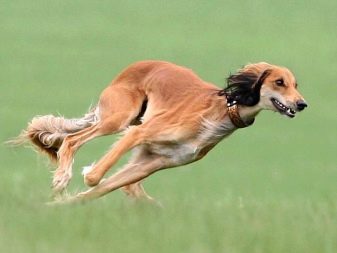
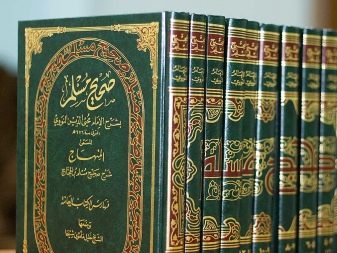
Another exceptional feature of these dogs was that they ate the same food as humans. Greyhounds have always been well watched: it was balanced and consisted of meat, camel milk and mashed dates.
The distribution of representatives of this breed in Europe took place in two stages. The first stage of distribution lasted until 1840. It is characterized by the fact that due to the emergence and fall of a number of empires in the Middle East, northern Africa and southern Europe (for example, the Roman Empire, the Empire of Alexander the Great), saluki spread throughout the Mediterranean coast. However, they did not maintain their purebredness and quickly mixed with other breeds.
These dogs took part in the Crusades in the XI-XV centuries.
However, their main occupation was still hunting. Both in Europe and in the Arab countries, they were kept by wealthy feudal lords, so hunting turned into a rank of entertainment and was a great event in which the cavalcades took part, up to fifty greyhounds and hunting falcons.
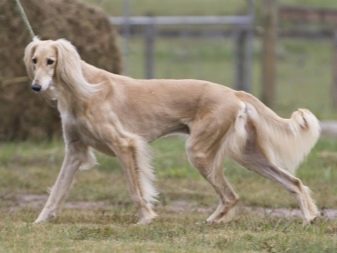

The second stage of the distribution of saluki in Europe began in the 19th century, when they began to be brought from Syria. In 1840, researcher Hamilton Smith brought several individuals from Persia. They were demonstrated at an amateur exhibition in Regent's Park. And already in 1874 the breed is mentioned in the Kennel Club's studbook as “Persian Greyhound”.
The next time representatives of this breed were presented at the exhibition in 1900. In 1923, the breed was recognized in England, and a few years later in the United States.
In Russia, saluki appeared in 1897 at a dog show. Then the dog Grumiz took a gold medal. However, breeding only began in the 1990s, after importing European breeding dogs.
The fate of saluki in the Middle East has been mixed. On the Arabian Peninsula, hunting is considered an indicator of human well-being, and trained purebred saluki can cost a fortune.
And in Iran, hunting is prohibited, and the police shot many dogs of this breed, the owners of which used them for illegal hunting. The most purebred individuals survived in Bedouin tribes living in deserts.

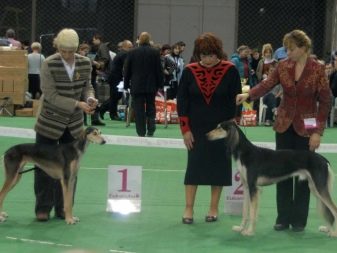
Description
Standard Number: FCI No269
Group: greyhounds for hunting and running.
Section: greyhounds with long hair or bristles.
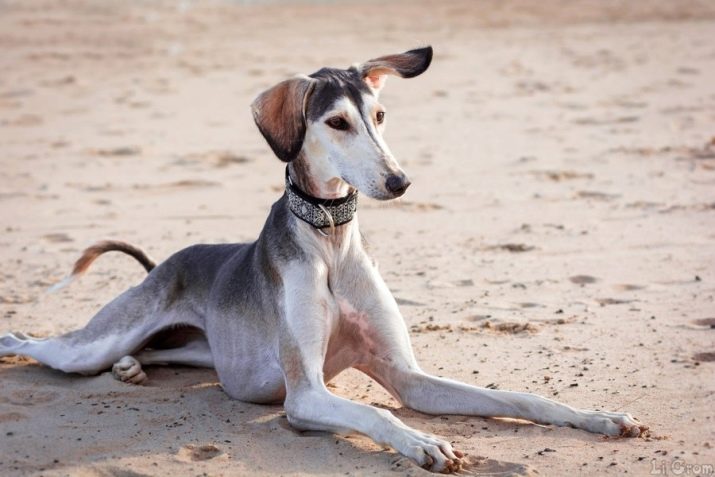
The general view of saluki is the embodiment of proportionality, grace and grace. There are many varieties, but there are common standards for all members of the breed.
- Head. The skull has a very elongated shape and is commensurate in width with the body. The transition from the forehead to the muzzle is mild. The gap between the ears is smooth, without bulges. The ears are mobile and set high, in a calm state they fit snugly to the head. There is a long soft coat on the ears. The dog should have an even bite. The nose can be black or brown. The eyes are large, but not bulging.
- Neck long, graceful, with well-developed muscles.
- Back wide enough. Deep, large chest, a tucked up stomach. The front of the body is much larger than the back.
- Tail should not be above the hock. It is set low and long enough. On the lower part there is a characteristic suspension made of soft wool.
- Forelimbs well laid back and well muscled. The shoulders and shoulder blades are approximately equal in length. Long, straight forearms turn into wide powerful metacarpals. On the hind limbs, the hock joints are well defined and the articulations of the knee joints are almost not pronounced.
- The coat is smooth and soft.. There are tows on the legs, tail and throat. Coarse or felted wool is considered a serious flaw.
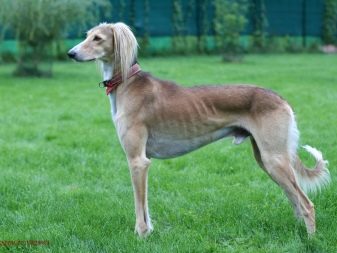
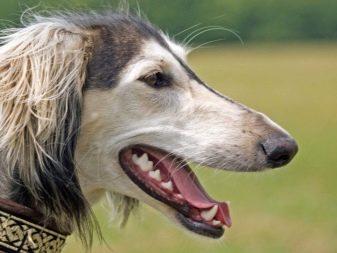
The main characteristics of an adult dog:
- weight - 14 - 27 kg;
- height - 60 - 70 cm;
- life span - 10-14 years.
Any color is allowed, but brindle is considered undesirable.But at the same time, the tiger color is not a vice and cannot be the reason for disqualification of a pet in competitions, for example.
It is interesting that the accepted standards of the Saluki breed were approved for the European breed, and purebred individuals living in Bedouin tribes often do not meet these standards in any way.
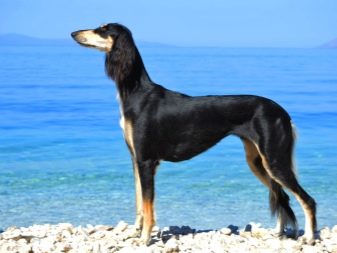
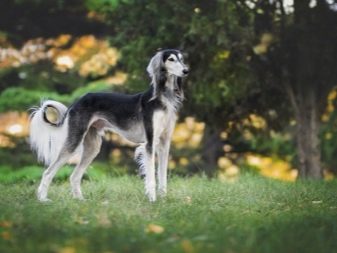
Character
Saluki are very intelligent, delicate, calm and sensitive. They can't stand it when they raise their voice. And it doesn’t matter whether they shout at them or in general. If the dog understands that a conflict is beginning, it tries to go to a place where no one will touch it.
They have a sense of dignity, sometimes turning into arrogance. This is expressed in the recognition of the owner of only one person. Of course, the dog will be friendly with all members of the family, but it will only carry out commands and serve one person.
Saluki do not like to contact with children. This is due to the fact that children often annoy animals and do not see personal boundaries. The dog will not start the conflict first, but if the child began to pester the animal, then she can stand up for herself.
There is one more thing to consider: if a dog is regularly nervous and does not give it the opportunity to be alone, then it turns into a tattered, nervous animal that will not make contact even with the owner.
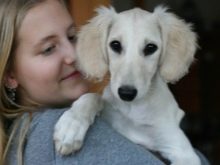
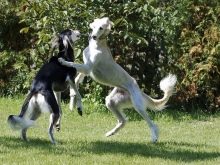

Saluki are quite restrained in the manifestation of emotions. For example, a dog will be completely indifferent to people unfamiliar to her and affectionate with those she knows (even if this person is not a member of the family). They never require special attention of a person, do not rush with the requirement of hugs. Sometimes there is a feeling that the owner of the saluki is needed only to feed, walk and scratch behind the ear. Interestingly, with such detached behavior, the animal sincerely loves the owner and can suffer from loneliness.
Saluki are sociable and fit well in packs. But at the same time they do not feel discomfort if there are no other tetrapods in their vicinity. Persian greyhounds in this regard are very independent.
The situation is different with other pets.
Due to the developed hunting instinct, the saluki perceive other pets as their prey. This behavior can be reversed with the help of prolonged training, but in many cases the instinct takes its toll and, for example, the cat becomes potential prey.
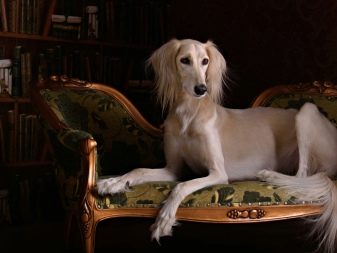
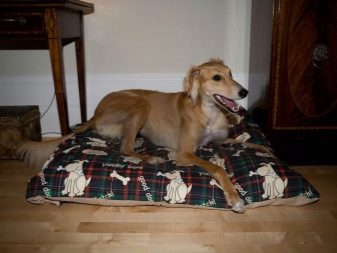

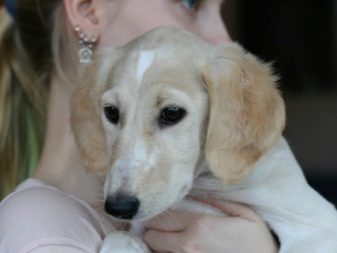
Conditions for keeping
Since the breed was formed in the hot climate of the Middle East, it is difficult to survive the cold weather. That is why saluki are not suitable for breeding and life in aviaries and booths - they are resettled there only for the summer.
Persian greyhounds are quite large and mobile dogs, so it is not recommended to start them in apartments. The most comfortable option for animals will be a house with a large plot. However, if the dog does not have enough movement, then she may voluntarily go for a walk.
Greyhounds have two characteristics:
- they need a lot of movement;
- they “drain the battery” in a very short time.
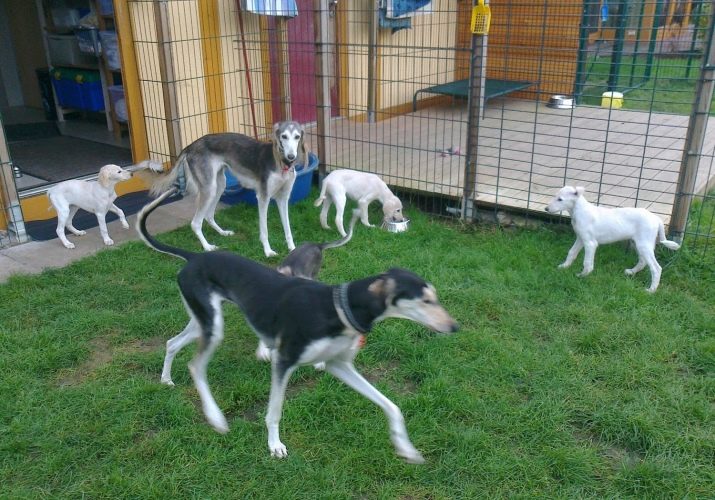
The average saluki is enough 40 minutes to walk up. But the walk itself is best done at a pace so that the dog has the opportunity to move around freely. It is advisable to do this in the fields. The bike for walking saluki is too slow, the speed of a scooter or motorcycle is more suitable. And remember that it is very difficult to curb the hunting instinct, so any moving object causes hunting passion in the greyhound.
Persian greyhounds are distinguished by excellent health, the basis of which lies in proper nutrition and sufficient physical exertion. Despite this, there are a number of diseases that can occur in a pet:
- dilated cardiomyopathy (cardiac abnormalities);
- hypothyroidism (malfunction of the thyroid gland);
- hemangiosarcoma.
Dog handlers recommend showing the pet to the veterinarian at least once every six months.
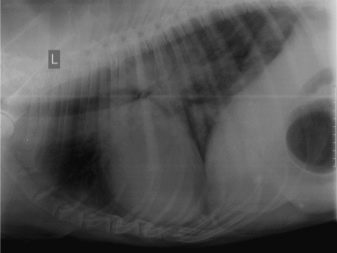

What to feed?
An interesting situation with food saluki.Among the representatives of this breed, gluttons are extremely rare, so a healthy animal decides how much he needs to eat. The diet and portion size depends on the degree of activity of the animal and its age.
The first 1.5 weeks after the puppy stops feeding the mother-dog, his diet is milk, cereals and nutritious mixtures. From about two months (when physical activity increases), the following are gradually added to the diet:
- meat;
- eggs (raw or mashed and added to porridge);
- porridge for meat broth;
- meat;
- vegetables.



An excellent option for feeding a puppy in the first few days after it is taken from the nursery will be ready meals from the breeder.
It’s better to feed the puppy at one time and in one place. The pet will quickly get used to its place and will not scatter food.
Cottage cheese and kefir are introduced into the diet of an adult saluki. In addition, the portion of meat is increasing. The rest of the diet remains the same.
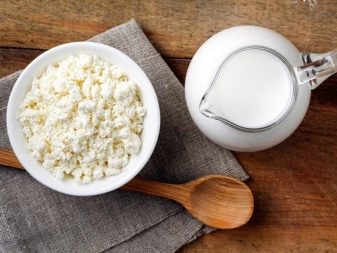
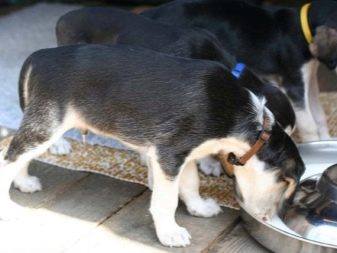
It is worth considering the following nuances:
- an adult dog can ignore unfamiliar products;
- the puppy is fed 2-3 times a day, an adult - 1-2 times a day.
Should be excluded from the diet:
- fatty foods;
- fried or smoked dishes;
- sweets.
The body of the saluki is very sensitive, and malnutrition leads to obesity, digestive problems, gastritis, allergies and other troubles.
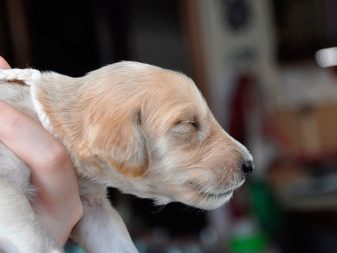
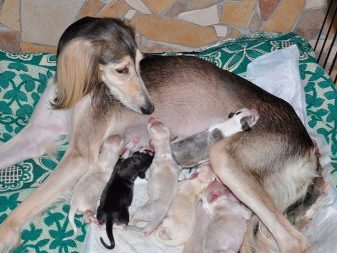
How to care?
Saluki rarely and shed little. Their coat, even when wet, does not emit an unpleasant odor. In addition, animals are naturally clean and will not sin by bathing in ditches. This becomes especially important when you consider that frequent water procedures are contraindicated for them. This is due to the fact that they have a very thin fat layer.
Experts do not recommend washing saluk more often than 2-3 times a month. In this case, you need to use gentle shampoos and balms (for easier combing), and after the procedure, dry the hair with a towel.
Particular attention should be paid to the ears (they must be cleaned once a month and must be wiped dry after the procedures) and to the claws (if the dog is active, the claws will grind on their own, and if physical activity is limited, then the claws should be filed and ground).

For hair care, it is recommended to stock up with ridges of different frequencies. They are needed in order to comb out the warlocks and burrs that the animal brings from a walk. In the summer, it is worth restricting the dog's stay in the open sun. This is due to the fact that Saluki are without undercoat.
During walks, it is recommended to bandage the feet of the pet and wear a special cover in order to protect the tail. However, these are ineffective measures, since during the run the dog discards all unnecessary.
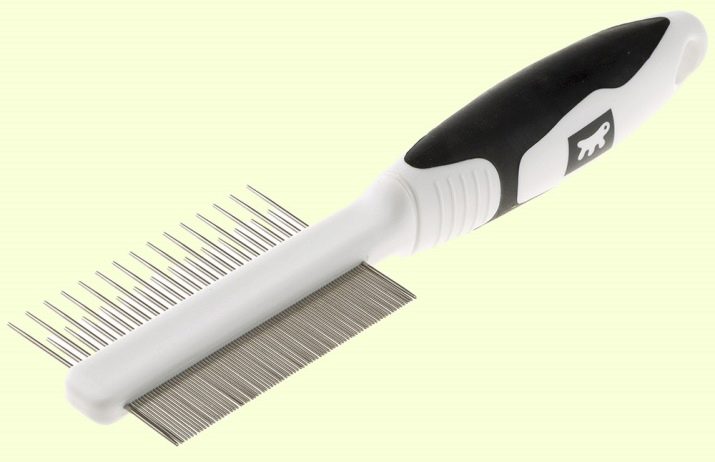
Training and education
The main purpose of training is to accustom the dog to the basic set of commands "sit", "not", "stand", "to me" and the like. Do not expect from the pet the execution of some complex commands. Saluki are still not circus dogs.
Training begins in 3-4 months. Before that, you need to accustom the pet to its place in the house, to establish relationships with him and mutual trust.
Since for thousands of years the main quality that developed in the saluk was a hunting instinct, they are reluctant to submit to training (and generally to the teams). And when chasing, the dog generally stops responding to anything.
Interestingly, until about two years old puppies demonstrate donkey stubbornness to the owners. Dog handlers attribute this to the fact that the animal tests a person for strength.

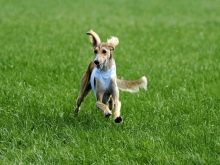
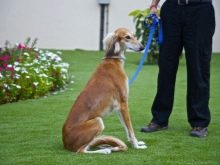
In order to facilitate control of the dog, apply special clickers. These devices emit clicks with which certain actions are associated with training. Cynologists also recommend using the method of "positive reinforcement", which consists in the fact that for obedience to the animal they give a treat. This method works especially well when saluki are addicted to their games and do not respond to clickers.
These dogs do not like to be repeated the same thing. They can react to a person 2-4 times, but if you repeat one command 10 times, the pet will simply ignore you.
Saluki love it when they talk to them, explaining the meaning of things and actions. This can be used if the animal is afraid of any procedure. The attention of the dog in the process of communication is easy to control.

About the features of the breed, see below.
